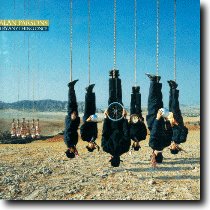| From the liner notes of the 24K gold CD:
From the sticker:
A SPECIAL LIMITED EDITION OF ALAN'S NEW ALBUM
ON A 24K GOLD CD WITH 20-BIT MAPPING
Includes:
TURN IT UP
OH LIFE [THERE MUST BE MORE]
THE ULTIMATE ALBUM TO TEST THE LIMITS OF YOUR CD PLAYER
|
From inside the left cover:
This disc is the product of three exciting technologies designed
to enhance the digital listening experience and increase the
quality of the disc itself.
First, Try Anything Once is a DDD recording. The DDD notation,
of course, means that the music has spent its entire recorded
life in the digital domain, from the studio to your compact disc
player, ensuring the highest possible digital fidelity.
Second, it has been manufactured on a gold disc. In this
fabrication process, a super-fine layer of 24K gold coats the
reflective metallic surface of the disc itself, guaranteeing long
life without any possibility of oxidation or deterioration of the
playing surface.
The third is a digital noise shaping process called Super Bit
Mapping (SBM[tm]), developed by Sony. SBM[tm] creatively adapts
the 20-bit "words" used in digital tape studio recordings to the
16-bit "language" of CD's. It does this by processing each 20-
bit "word" (actually an electronic "sample" of a waveform) through an
algorithm designed to minimize noise in the most sensitive
portion of our hearing range. The result is not only lower noise, but
reduced harmonic distortion, a greatly expanded sense of
atmospherics, sonic "warmth" and more detailed musical perspective.
From inside the right cover:
From The Beatles' Abbey Road, Pink Floyd's The Dark Side Of The
Moon and his work with the likes of Paul McCartney, George
Harrison, The Hollies and Al Stewart, to all the classic albums
that have carried his name,
Alan Parsons
has helped shape the
sound of rock as we know it today. As the guiding force behind
The Alan Parsons Project, albums like
I Robot,
Pyramid,
Eve,
The Turn Of A Friendly Card,
Eye In The Sky and
Ammonia Avenue
became recognized as some of the most consistently innovative and
adventurous music of any time.
Try Anything Once, the new album from
Alan Parsons,
is the
result of 100 days of recording at his state-of-the-art home
studio in Sussex, England. The new album, his first in six
years, features vocal performances by Parsons staples like
Chris Thompson
(Manfred Mann' Earth Band) and
Eric Stewart
(10cc), as well as from newcomers
David Pack
(Ambrosia) and
Jacqui Copland
(Duran Duran). Joining Parsons to form the core band are mainstays
Ian Bairnson
(guitar),
Andrew Powell
(keyboards) and
Stuart Elliot[t]
(drums), all of whom collaborated with Alan on the songwriting.
Though the albums soars far and wide lyrically, offering reflections
on life, fate and the soul from a variety of perspectives,
Parsons
cautions that it's not a unified conceptual statement in the way
some of "The Project's" works were. "There isn't one consistent
theme," he notes. "If you find one, I'd like to know about
it." What remains consistent, of course, is
Alan's
trademark of richly
layered, challenging instrumentation that reveals new dimensions,
and surprises, with each repeated listening.
Try Anything Once is the culmination, and continued evolution,
of an extraordinary career. And, what better way to hear it in
all its sonic brilliance than on this bit of incredible
technology. So, sit back, and enjoy a truly astounding aural voyage.
From the rear:
This recording incorporates Sony's revolutionary 20-bit "super bit
mapping" process which reproduces music with unprecedented
clarity and accuracy. In addition to SBM, this disc features a pure 24-
karat gold reflective surface and deluxe packaging.
- Wesley Chun |
| The holusion image appearing in Blue/Yellow/Green patterns found
in the liner notes is identical to the image on the regular issue
of the compact disc, but in Red/Yellow/Orange patterns instead.
The Gold CD release has no holusion on the disc. The disc is
empty except for "Try Anything Once" and "Alan Parsons" written
around the edge of the disc. There are no track listings or
times listed either. It is VERY plain. In fact, if you hold
the disc up to a light source, it is transparent.
- Wesley Chun |
| If you have information, links or pictures which you believe
could enhance this entry, please
contribute.
|
| 
 Credits Credits |
|---|
 Miscellaneous Links Miscellaneous Links |
|---|
| No offsite links |
|

 Track Listing
Track Listing Credits
Credits Miscellaneous Links
Miscellaneous Links